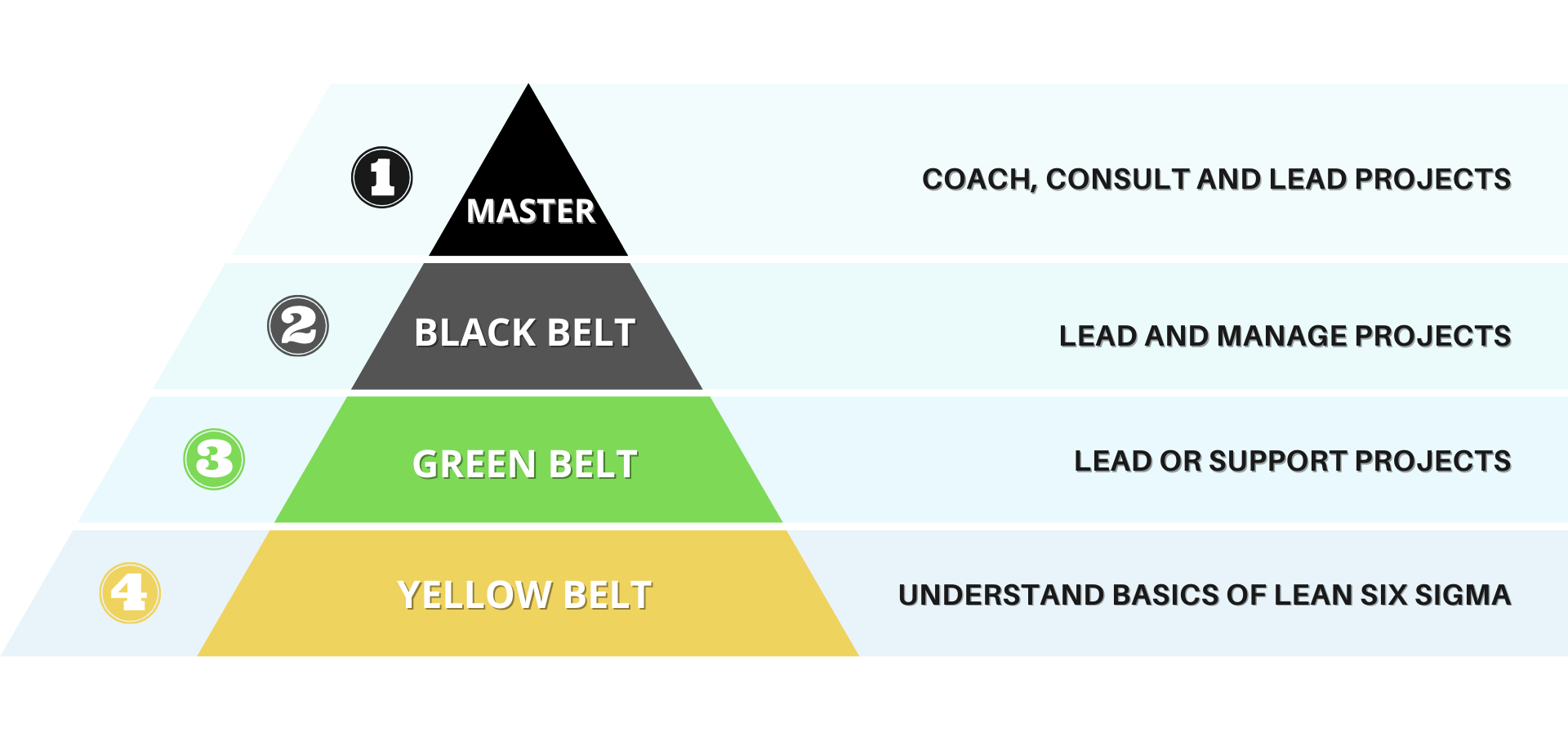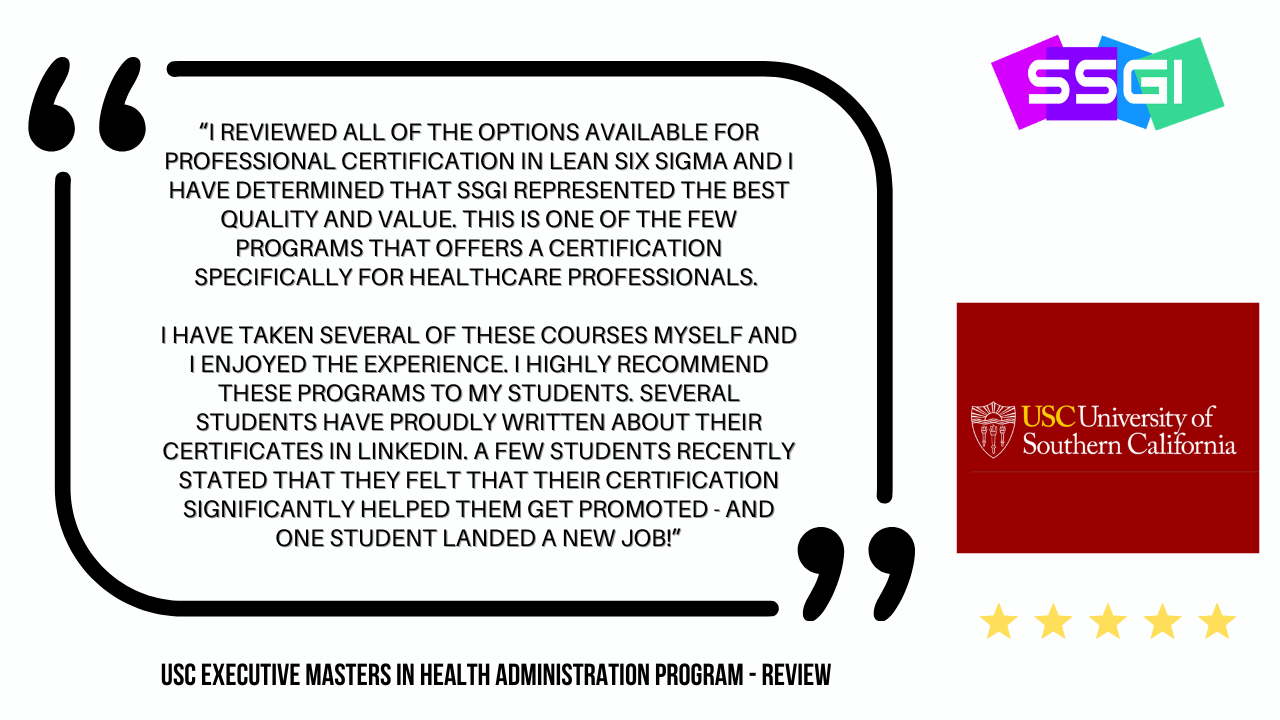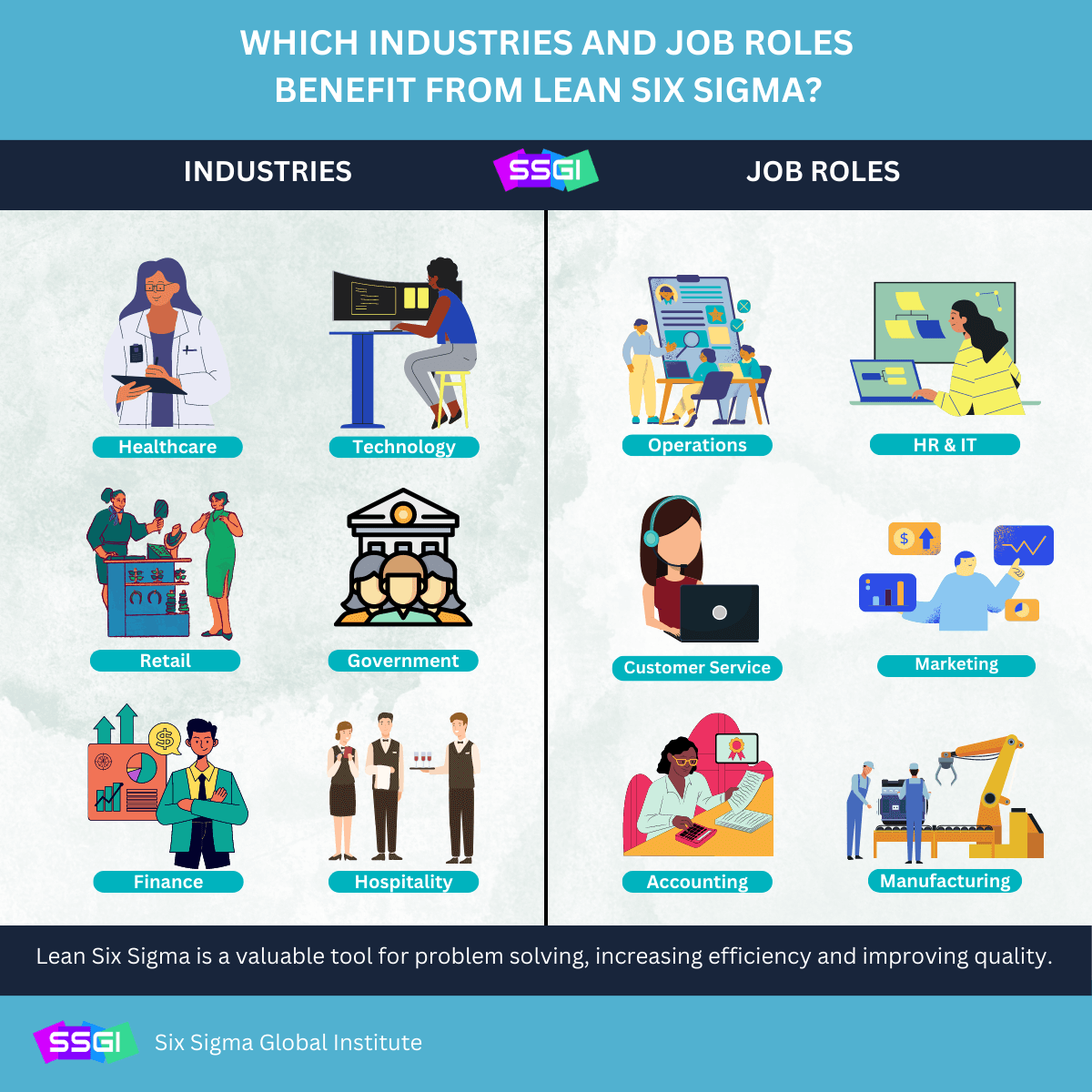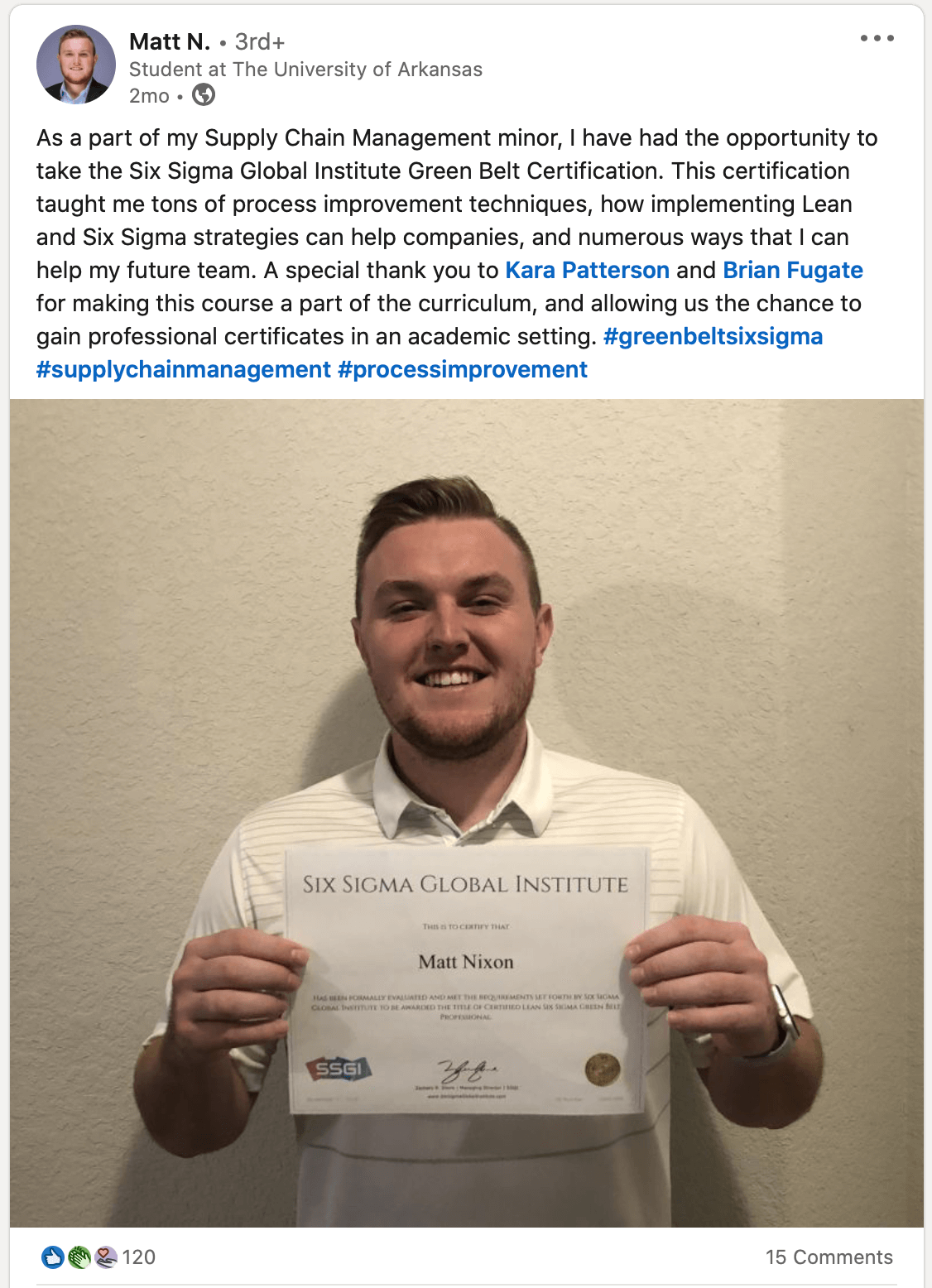Six Sigma Certification: The Definitive Guide
Learn everything you need to know about process improvement and quality management with our comprehensive Definitive Guide to Six Sigma Certification.
Designed for professionals eager to elevate their expertise, this guide serves as your essential roadmap to understanding and achieving Six Sigma Certification. Dive into the world of Six Sigma certification and discover how this globally recognized certification can transform your career.
Sections Include:
Section 1:
Understanding Six Sigma Certification

In the dynamic and competitive landscape of modern business, distinguishing oneself as a professional and adding value to one’s company are critical. Achieving a Six Sigma certification signifies this distinction, demonstrating an individual’s dedication to excellence, capability in driving substantial enhancements, and expertise in minimizing inefficiencies and waste. The question arises, why is it significant to obtain Six Sigma certification, and what advantages does this qualification offer to both individuals and their organizations?
Introduced by Bill Smith in 1986 while he was a senior engineer and scientist at Motorola, Six Sigma emerged as a methodological approach aimed at enhancing the efficiency of organizational processes across every sector. The inception of Six Sigma marked a pivotal moment for global corporations, offering a blueprint for operational scalability and performance enhancement. Since its establishment, Six Sigma has been instrumental in providing businesses—and their leaders—with innovative strategies to address contemporary challenges in business management.
Although the term “Six Sigma” might evoke thoughts of academic societies, it is in fact a robust and universally applicable method for addressing process-related challenges across various industries. Are you intrigued by the prospect of refining processes, solving intricate issues, and steering a company towards success? If so, pursuing Six Sigma certification could be a strategic move in your career development.
Six Sigma revolves around five key principles: Define, Measure, Analyze, Improve, and Control (DMAIC), which guide the improvement of existing processes. Additionally, there’s Design for Six Sigma (DFSS), which includes methodologies like DMADV (Define, Measure, Analyze, Design, Verify) for creating new processes or products.
| Phase | Description |
|---|---|
| Define | Identify the project goals and customer (internal and external) requirements. |
| Measure | Measure the process to determine current performance; collect relevant data for future comparison. |
| Analyze | Analyze and determine the root cause(s) of the defects. |
| Improve | Improve the process by eliminating defects. |
| Control | Control future process performance to ensure that any deviations from the target are corrected before they result in defects. |
The Six Sigma certification ladder consists of several levels, starting from the White Belt, which introduces the basics, to the Master Black Belt, which signifies a high level of expertise and leadership. Each level equips professionals with various skills and knowledge, preparing them for specific roles within projects and organizations.

| Certification Level | Description |
|---|---|
| White Belt | Understands basic Six Sigma concepts and supports overall projects. |
| Yellow Belt | Participates as a project team member and uses Six Sigma tools in small projects. |
| Green Belt | Leads projects and applies Six Sigma methodology for process improvement. |
| Black Belt | Manages big projects, trains and coaches project teams using Six Sigma tools. |
| Master Black Belt | Acts as an organization’s Six Sigma technologist and internal consultant. |
The relevance of Six Sigma certification continues to evolve with business trends, including the integration of Six Sigma principles with emerging technologies and methodologies to address the challenges of the digital age.
A common question surrounding Six Sigma certification includes, is Six Sigma outdated? Do companies still use Six Sigma?
The methodology of Six Sigma is being adopted at a faster rate than ever. As the gold standard for companies becomes efficient and effective operations, the principles and framework surrounding Six Sigma plays an integral role in allowing organizations to achieve operational excellence. From silicon valley and leading tech firms, to global banks and healthcare institutions, efficiency is the gold star. And the way to to get there is Lean Six Sigma. That is why now is the best time ever to consider getting Six Sigma certified.
Section 2:
Unlock career advancement opportunities with Six Sigma certification

Securing a Six Sigma certification undoubtedly equips you with fresh insights and abilities that you can utilize in your everyday tasks. Although this represents a significant advantage, it barely scratches the surface of the true value certification offers.
Achieving Six Sigma certification offers a multitude of benefits, including sharpening problem-solving skills, increasing your marketability in the job market, and potentially leading to higher salaries due to the valuable expertise certified professionals bring to an organization.
Below are the foremost advantages of achieving your Six Sigma certification.
Increase your earning potential substantially with a recognized Six Sigma Certification.
Open the door to new job opportunities and leadership positions.
With valuable analytical and process improvement skills, few businesses will be able to afford to lose you.
In a global market where competition is fierce, being Six Sigma certified demonstrates to HR, hiring managers and clients that you are committed to quality and efficiency.
Earning certification also opens the door to:
Recognition of Your Expertise and Commitment
Being Six Sigma certified is not just about having a new title or a certificate to hang on the wall. It’s a recognition of your expertise in one of the most effective methodologies for process improvement and quality management. This certification demonstrates your commitment to continuous improvement, both personally and professionally, and signifies that you have undergone rigorous training to master these skills.
Enhanced Career Opportunities and Earning Potential
Six Sigma certification opens the door to enhanced career opportunities. Many employers specifically seek out Six Sigma certified professionals for their proven ability to analyze and improve their operations. This demand spans across various industries, including manufacturing, healthcare, finance, and IT, making Six Sigma skills highly versatile and transferable. Moreover, individuals with Six Sigma certification often enjoy a higher earning potential, as their skills directly contribute to increasing efficiency and reducing costs within their organizations.
Six Sigma certification can also demonstrate to employers your abilities and commitments on a number of other levels, such as:
Team Contribution: Showcase to employers that you can contribute as a team member to a Six Sigma or process improvement project
Individual Initiative:. By taking the inititave to earn a certification, you show your dedication to professional development and this shows potential employers that you have a strong commitment to your professional values.
Improved Resume: Add credibility with recognized certification. Many job descriptions list six sigma certification as a requirement. In fact, many leading organizations prioritize higher those who are six sigma certified.
Leadership Skills: Develop leadership skills with a better understanding of how the organization can become more efficient while delivering high quality outcomes.
Value Added Asset: At the end of the day, organizations place priory on higher those who are value added assets. If you can showcase to a company that you can come in with a pure defined skill set for solving problems and making their organization more efficient and effective, you will instantly stand out from the competition.
Section 3:
Making the decision if Six Sigma certification is right for you

Deciding whether Six Sigma certification is worth it involves weighing the potential benefits against the costs and considering your career goals. For those committed to excellence in quality management and process improvement, Six Sigma offers a powerful toolkit.
The choice to seek a Six Sigma Certification hinges on your career objectives. If your ambition is to emerge as a leader, a visionary problem solver, and a crucial contributor to your organization, then embracing Six Sigma might be a prudent decision. Nonetheless, it’s important to consider various factors and ensure your professional growth investments are well-placed.
Below are four compelling reasons to consider obtaining a Six Sigma Certification:
Businesses across a wide array of sectors that emphasize Six Sigma in their job postings are often among the most renowned worldwide. The following enterprises are noted for their preference for hiring candidates with Six Sigma certifications for specific roles:
These organizations appreciate the Six Sigma approach for its effectiveness in streamlining operations, minimizing inefficiencies, and boosting quality and productivity. Career opportunities within these entities span diverse areas such as operations, quality control, production, process enhancement, and project leadership.
| Six Sigma Certification Level | Associated Job Titles (Examples) |
|---|---|
| White Belt | Quality Assurance Associate, Analyst |
| Yellow Belt | Process Improvement Specialist, Quality Analyst, Project Manager |
| Green Belt | Project Manager, Quality Supervisor, Process Analyst, Quality Manager |
| Black Belt | Process Improvement Manager, Consultant, Senior Project Manager, Operations Manager |
| Master Black Belt | Process Improvement Director, Scrum Master, Site Leader, Operation Director |
The value of being Six Sigma certified is multifaceted, offering significant benefits to both individuals and organizations. It matters not just as a credential, but as a testament to one’s ability to drive meaningful change. Whether you’re looking to advance your career, improve your organization’s operations, or foster a culture of continuous improvement, Six Sigma certification is a powerful tool in your professional arsenal.
There are, of course, many factors that determine salaries paid to those who are certified in Six Sigma. Some of these factors include:
Note: The numbers shown below are based off of information provided by indeed.com. Several other factors come into play when determining your salary potential, such as prior experience, location, educational background, etc.

Section 4:
The Investment into Six Sigma Certification

Pursuing Six Sigma certification requires an investment of both time and money. The total cost and time commitment vary depending on the certification level, type of delivery and the training provider. However, the return on investment can be substantial, both in terms of personal career growth and organizational benefits.
To decide which six sigma certification is best for you, consider the different formats available such as:
| Six Sigma Training Method | Cost | Flexibility | Ongoing learning | Learning Environment |
|---|---|---|---|---|
| Online | Low | High (Self-paced) | Yes, continued access to training materials and resources depending on provider. | Remote |
| In-Person | Very High | Low (Scheduled classes) | No/Limited. | Classroom |
| Virtual-Led Online | High | Medium (Scheduled) | Limited depending on provider. | Remote, interactive |

The length to complete a specific six sigma certification is dependent upon the topical coverage, prior knowledge, time availiabilty, provider and type of delivery method being offered.
As a general standard you can expect to complete a six sigma program within the timeframes listed below. We also provide links to more in-depth explanations on how long does it take to get six sigma certified?
The answer is not quite straightforward because it depends upon a person’s background and the amount of time that can be devoted to studying for the exam. But here is an approximation. Let’s assume an individual has little training in engineering, math or the sciences. In addition, assume they have little experience in quality control. Using this as the baseline it will take about two to four weeks to earn a Yellow Belt, and about 6 to 12 weeks to earn a Green Belt.
Now consider a person who does have experience in quality control or has taken recent courses in the physical sciences. The Yellow Belt should take between one to two weeks, the Green belt should take between four to seven weeks and the Black belt, assuming that person has already earned a Green Belt, should take between six to 12 months.
When researching Six Sigma training and certification, you will notice a wide range of price offerings. As previously mentioned this can be dependent upon the delivery method such as on-line, instructor led or in-person. However still, prices can vary significantly between providers.
To get a better sense of pricing and why some options are more affordable than others you should consider the following.
University Providers
University based offerings such as those offered through Villanova and Purdue are priced on the high end. The reason comes down to the name associated with the certification (universities historically charge higher prices) as well as the overhead costs universities incur. In addition, many universities have third-party organizations who offer their certification programs or partnerships with professors. In both of these cases, the university is subject to paying out royalties and fees. With all things considered, these are the general reasons why universities charge a high price when it comes to Six Sigma certification.
Third-party training materials
An interesting fact that many people do not realize is that 75% of online Six Sigma training providers do not develop the training internally. Instead they are using third-party training resources. Because of this agreement with a third-party agency, these training providers are paying fees for each and every sale. This results in the providers raising their prices to allow for profits to be made.
Recognition
A common question often asked is, are all certification providers and certifications equal?
Not at all. There are many providers who have no name behind their programs and educational materials. You should always see if a website offers an about us page that includes details about the specific individuals within the organization, especially the course developer. If you stumble on a website that lacks this information, you should proceed with caution. There are also a number of other industry approvals and accreditations you can take into consideration such as Project Management Institute (ATP). Also look to see if the provider has forged any recognized partnerships within industry. This is one of the best signs that your certification will be well respected by employers.
Section 5:
Understanding the Six Sigma Belt Levels
Six Sigma certification is divided into belts, which represent different levels of expertise. Each belt is associated with a professional certification. These levels range from Six Sigma for beginners to Six Sigma for experts.
While some institutes offer a White Belt certification, this certification is usually achieved within 30 minutes of minimal training. Because of this, there is little weight of importance within industry placed on this level of certification. However, like many things in life, a little is better than nothing.
 Yellow Belt: Introductory into process improvement concepts and tools.
Yellow Belt: Introductory into process improvement concepts and tools.
Yellow Belts can work with Six Sigma teams and assist in data collection, analysis and implementation of results. It is the first step in the path to even higher levels of Six Sigma certification.
 Green Belt: Intermediate-level program for those looking to work within process improvement teams.
Green Belt: Intermediate-level program for those looking to work within process improvement teams.
The Green Belt level covers the full range of topics that represent the Six Sigma body of knowledge. Those who have earned this level of certification work under the supervision of a Black Belt.
 Black Belt: Advanced program for those looking to lead and mange continuous improvement projects.
Black Belt: Advanced program for those looking to lead and mange continuous improvement projects.
Black Belts has developed proficiency in the complete body of knowledge associated with Six Sigma and can lead small projects.
 Master Black Belt: Subject mater expert that is prepared to coach and lead organizational wide initiatives.
Master Black Belt: Subject mater expert that is prepared to coach and lead organizational wide initiatives.
Master Black Belts have developed proficiency in the body of knowledge and are capable of managing large-scale projects supervising those who hold Yellow through Black Belt certifications.
Some common questions for those considering Six Sigma certification are, Which belt should I take? Can I go directly to the Black Belt? Is it fine to skip belts?
The answer to these questions depend on a number of factors such as:
Below we provide you with a general guideline on choosing which Six Sigma Belt is best for you.
Take the yellow belt first if you are new to this discipline, have little experience in process management, and have an educational background that placed less emphasis on math and science.
Why do we recommend the Yellow Belt?
It is important that your first foray into Six Sigma be successful, so starting at the Yellow Belt level will be quite approachable and also build your confidence in an area that may be new to you. In fact, it may not even be necessary for some people to go beyond the Yellow Belt. They may only be peripherally engaged in process design and management and only need the basic fundamentals to sharpen their skills as they interact with operational people or move up the management ladder.
The Green Belt is more challenging than is the Yellow belt because it relies on basic statistical concepts to support the design and management of operational processes. But even if statistics is not your strong suit, this should not deter you. However, you must find a course that focuses on concepts as well as statistics. If you don’t understand the concept, then mastering the statistical tools that support the concept can be very challenging and even frustrating. On the other hand, if you first understand the concept the statistics becomes much more manageable.
Why do we recommend the Green Belt?
The Green Belt serves as one of the most popular Six Sigma certifications. It is the perfect intermediate program for those who are serious about diving into process improvement and looking to earn a credential that stands the test of time and differentiates them from the competition. If you are a project manager or seeking to become more involved in roles that open the door to leadership possibilities, this level of certification is for you.
A Black Belt course should only be taken by those who some prior experience and who have earned a Green Belt. It requires a more in-depth understanding of statistics and often also requires a higher score to pass the certification exam. In general, those with a math, engineering or science background have an easier time at the Black Belt level, but a background of this nature is definitely not necessary to take the course. It just may take a little longer to master the material.
Why do we recommend the Black Belt?
It is critical that managers and leaders have the tools and resources availabe develop efficient processes and deliver high quality results through projects, services, products and customer service. If you have previous experience in process improvement or have been involved in these types of projects but have not received formal training, the Black Belt could be the perfect program. This advanced level certification dives into statistical tools and methods used to Define, Measure, Analyze, Improve and Control processes. It is an essential for any leader who is looking to take their performance and career to the next level.
The Master Black Belt course is only available to those who hold a Black Belt certification. It is an industry requirement that you must first obtain a Black belt, prior to earning a Master Black Belt. This program is intended for those who want to become subject matter experts and lead Yellow through Black Belts. It is also applicable for senior level managers who are running company wide improvement initiatives.
Why do we recommend the Master Black Belt?
For those seeking the highest possible level of approval in Six Sigma, the Master Black Belt will give you a complete 360 view on process improvement and various management tactics to lead organization wide continuous improvement initiatives.
Because each belt level in Six Sigma is specific to a certain degree of pre-existing knowledge, the topical coverage of concepts and tools vary depending upon the certification belt. The Six Sigma tools you will learn at the White Belt level are different than those covered at the Black Belt level.
Below we have created a chart that shows which Lean Six Sigma tools you can expect to learn and and which level.
| Belt Level | Associated Tools |
|---|---|
| White Belt | Basic Problem-Solving Tools, 7 Quality Tools (Overview) |
| Yellow Belt | Cause-and-Effect Diagrams, Flowcharts, Check Sheets |
| Green Belt | Statistical Analysis Software, Process Mapping, Failure Modes and Effects Analysis (FMEA) |
| Black Belt | Design of Experiments (DOE), Advanced Statistical Analysis, Hypothesis Testing |
| Master Black Belt | Leadership and Change Management, Advanced DOE, Complex Systems Analysis |
Section 6:
The Six Sigma certification process

You have 3 main steps to make when it comes to getting six sigma certified.
The 3 steps in the certification process are:
Note: Some providers like IASSC do not offer training. So you will have to find a training provider separately and pay an extra fee. If you choose such a provider, make sure that there approved training provider list includes institutes located within North America if earning a six sigma certification from a U.S. recognized institute means something of value to you.
When selecting a Six Sigma certification or training provider, several aspects should be evaluated. Consider everything from customer feedback to the reputation of the person conducting your training. It’s important to ensure that the program is not just well-known but also provides you with the hands-on skills needed to apply the learned concepts effectively.

It is important to recognize that there is no official or centrally recognized authority that authorizes accreditation in Lean Six Sigma. Wikipedia states that, ”There is no standard certification body, and different certification services are offered by various quality associations and other providers against a fee.”
To assure that a reputable provider is chosen, several issues need to be explored.
Some training programs are very technical and rely on equations and formulas. For example, the standard deviation, a measure of process variation, can be represented as a formula. But the real learning is beyond the formula. It is an understanding of how the standard deviation is a measure of process variation and how that can help in monitoring and controlling process output. This concept is at least as important as the formula. Why? Because the concept will shape how you focus on a problem when engaged in a project. Once engaged, the formulas can always be accessed from the training material.
So, it might be advisable to look for a training program that focuses on concepts first and formulas second.
Below is a list of the best Six Sigma certification providers. You can view pros and cons about each provider.
| Provider | Why You Should Consider | Why You Shouldn’t Consider |
|---|---|---|
| ASQ | Seeking highest-level of Six Sigma certification or are a high-level executive. | High prerequisites; Price; Training sold separately; Renewal fees. |
| IASSC | Seeking certification without training that is recognized outside of North America. | Located in Cyprus with under 10% of approved provider in North America; Renewal Fees; Training sold seperate. |
| SSGI | If you are seeking on-demand affordable training and certification developed by an authority (Prof. Barry Shore) that is industry trusted (Baldrige Partner). | Seeking the cheapest option available on market. |
| Villanova | If you are seeking schedule based training with video instructors in a classroom environment. | Expensive price; Schedule based; Recurring Fees |
| Simplilearn | Flexible schedule with weekly bootcamps. | If you live in the U.S., a certification from India may not hold as much appeal as a U.S. based institute. |
Does Six Sigma certification require renewal? What are the requirments?
Depending on where you get trained and certified, there are a few requirements that might be present that you should take into consideration before choosing a six sigma certification provider. There is no set industry standard for any of these items.
These items include:
Some providers make it required that you renew your certification every so many years. In addition, this is almost always associated with a fee that must be paid in order to maintain your certification. Unfortunately, not all providers are the same and just like any other industry there is nickel and dimming that goes on which results in companies trying to suck you into securing revenue models.
One item that can be very annoying for those trying to achieve six sigma certification, is the separate fees associated with exam retakes. Once again this varies depending on the provider, however there are many institutes that charge per exam attempt.
Some institutes require prior experience, signed documents of project approvals and or previous Belt completion in order to advance to a certain Six Sigma certification level. Make sure you read the requirements set forth by each provider as this varies considerably.
Once you have achieved Six Sigma certification status, it might be of interest to you at some point in the future to consider taking on a higher level belt. Each certification belt (White, Yellow, Green, Black, Master Black) builds off the preceding belt level. They have been designed to take you from basic introductory (White Belt) to expertise (Master Black Belt). Each level brings with it new responsibilities and opportunities for career advancement.
Section 7:
Which industries and job roles use lean six sigma?

| Industry | Job Roles | Benefits of Six Sigma |
|---|---|---|
| Manufacturing | Process Engineer, Quality Assurance Manager | Improves production processes, reduces waste, enhances product quality. |
| Healthcare | Healthcare Administrator, Clinical Project Manager | Increases patient satisfaction, optimizes operational efficiency, reduces errors. |
| Finance | Financial Analyst, Risk Manager | Enhances risk management, improves compliance, streamlines processes. |
| IT and Software | IT Project Manager, Software Quality Manager | Facilitates project management, improves software development lifecycle, ensures quality deliverables. |
| Telecommunications | Network Operations Manager, Service Quality Manager | Optimizes network operations, improves service quality, enhances customer satisfaction. |
See how Six Sigma is applied in the real-world.
Taking a look at the application of Six Sigma methodologies unveils groundbreaking transformations across multiple sectors, with remarkable implementations seen at Starbucks, General Electric (GE), and Microsoft. Each narrative showcases a distinct path towards harnessing Six Sigma for operational refinement, efficiency enhancement, and elevating customer satisfaction.
Starbucks and Lean Six Sigma
 Starbucks, recognized globally as the premier coffeehouse chain, embraced Lean Six Sigma to blend the rapid service of fast-food with its signature customer experience. This initiative led to the introduction of forward-thinking practices, such as baristas taking orders in advance and a mobile app for expedited order placement and payment, drastically cutting down wait times. Starbucks prioritized preserving personal customer interactions, a move that ensured operational efficiencies bolstered rather than compromised the quintessential Starbucks ambiance. This example demonstrates how the service and hospitality industries can leverage Six Sigma to boost operational efficiency while maintaining their distinct brand essence.
Starbucks, recognized globally as the premier coffeehouse chain, embraced Lean Six Sigma to blend the rapid service of fast-food with its signature customer experience. This initiative led to the introduction of forward-thinking practices, such as baristas taking orders in advance and a mobile app for expedited order placement and payment, drastically cutting down wait times. Starbucks prioritized preserving personal customer interactions, a move that ensured operational efficiencies bolstered rather than compromised the quintessential Starbucks ambiance. This example demonstrates how the service and hospitality industries can leverage Six Sigma to boost operational efficiency while maintaining their distinct brand essence.
The Six Sigma Transformation at General Electric

In the late 1980s, under CEO Jack Welch’s guidance, GE embarked on a Six Sigma voyage, setting a new standard for corporate excellence in America. Launched in 1995, this initiative was a response to the pressing need for a comprehensive operational overhaul. GE invested heavily in training and mentorship, instilling Six Sigma methodologies, particularly the DMAIC framework, across its workforce. This strategy led to a remarkable saving of twelve billion dollars, illustrating Six Sigma’s impactful role in enhancing GE’s operational dynamics and pioneering a model for other corporations to follow.
Microsoft’s Strategy with Lean Six Sigma

At Microsoft, the incorporation of Lean Six Sigma principles significantly contributed to its sustained success and evolution in the competitive tech arena. Challenged by rivals like Apple in the mid-90s, Microsoft turned to Lean Six Sigma tools, such as value stream mapping, to quickly meet evolving customer needs. This strategic shift was crucial for developing the Windows CE OS platform, a key milestone in Microsoft’s product lineup. Further, in the late 2010s, Microsoft applied Six Sigma techniques to restructure its leadership, promoting a culture of perpetual improvement and aligning its operations with new technological advancements. This move streamlined their organizational structure and improved market responsiveness, showcasing Six Sigma’s adaptability across different business functions.
These narratives highlight the adaptable and impactful nature of Six Sigma and Lean methodologies across varied industries. Focusing on enhancing process efficiency, customer contentment, and operational effectiveness, entities like Starbucks, GE, and Microsoft have reinforced their industry leadership, setting new benchmarks for quality and innovation.
Section 8:
What is better? MBA, PMP or Six Sigma certification?

While Six Sigma focuses on reducing process variation and improving quality, it is often compared with other methodologies like Lean management for its focus on efficiency and waste reduction, and PMP for its emphasis on project management skills.
Despite its widespread adoption, Six Sigma is not without its critics. Some argue that it can be overly complex or rigid. However, when properly implemented, it provides a structured framework that can lead to significant organizational and personal benefits.
Six Sigma Certification and Project Management Professional (PMP)® Certification cater to different aspects of business management, focusing on process improvement and project management, respectively. While both certifications aim to enhance business outcomes, their approaches and areas of application distinguish them significantly.
The main differences between the two certifications can be summarized as follows:
Despite these differences, both certifications share the common goal of improving business performance. They can complement each other, with Six Sigma providing tools for process optimization and PMP® equipping professionals with the skills to manage projects efficiently. Professionals who possess both certifications can leverage their unique combination of skills to identify areas for improvement and apply project management techniques to implement effective solutions, ultimately benefiting their organizations and advancing their careers.
Choosing between pursuing a Six Sigma certification and an MBA involves considering your career goals, industry, and the specific skills you wish to develop. Both paths offer valuable benefits but cater to different professional needs.
Both an MBA and Six Sigma certification can significantly enhance your career, but they serve different purposes. If you’re aiming for a broad understanding of business and aspire to leadership or managerial positions, an MBA might be the right choice. If your goal is to specialize in process improvement and operational efficiency, a Six Sigma certification could offer the targeted skills you need.
Interestingly, combining an MBA with Six Sigma certification could provide a competitive edge, blending strategic business management skills with specialized process improvement techniques. This combination can make you exceptionally valuable to employers, equipping you with a comprehensive skill set to drive both strategic initiatives and operational excellence within organizations. In today’s business environment, an MBA may not be enough, so it is essential to taker the extra steps needed to stand out from the competition.
Section 9:
How Six Sigma can help advance your career
From manufacturing to healthcare, getting Six Sigma certified can make a significant difference in your career trajectory. Take a look at some of the Six Sigma success stories that Six Sigma Global Institute has received from various clients across multiple industries.
Section 10:
Put your certification to work

Those with Six Sigma credentials need to be proactive in using those skills to make a real contribution to organizational performance. The best way to do this is to find an opportunity within your organization that will benefit from either an improvement in efficiency or an improvement in quality outcomes or both. Find out as much as possible about the project. Create a SIPOC chart and draw a Value Stream Map. Document the problem. Use data. Propose how you would improve the situation. Above all, be proactive. Find an opportunity, follow the DMAIC framework and show management that you are logical thinker and capable of solving problems.
Follow these steps:
If, on the other hand you are looking for a new job and are engaged in telephone interviews or in-person interviews, keep on the lookout for Six Sigma opportunities. Ask questions. What problems have you had lately? What concerns have your customers raised? How do you think your operations can be improved? What do your competitors do that needs to be explored so that you stay competitive?
The way to find opportunities is to ask questions and be curious. You will be amazed at how many opportunities you will discover.
Now, your objective here is not to be a professional consultant and solve a major problem on the spot, but to let them know that you’re training in Six Sigma can help solve real problems. And, to let them know that you are competent is this critical area.
Section 11:
Frequently asked questions about Six Sigma certification
Yellow Belt – $65,000
Green Belt – $95,000
Black Belt – $126,000
Master Black Belt – $205,000
This depends on the amount of time you have to dedicate, prior knowledge, learning style and the specific course you enroll into. For a general answer you can expect to spend the following time to complete the associated programs below.
Yellow Belt: 1-2 weeks
Green Belt: 2-4 weeks
Black Belt: 1-2 months
Master Black Belt: 1-2 months
Just think, do companies care about quality and efficiency? Do they care about customer satisfaction and improving processes to deliver the highest quality services and products possible? Yes, Six Sigma is a fundamental skill that plays a crucial role within leading organizations around the world. By earning this certification you instantly stand out from the crowd and prove yourself as a value added asset to any organization.
Six Sigma certification is a great addition to your resume.It showcases your initiative towards professional development and also proves to employers that you have the skills that are crucial in today’s highly competitive and efficiency driven environment.
Yes, Six Sigma certification can be pursed and completed fully online.
Earning a Six Sigma certification from a reputable provider can make a world of a difference. We recommend always taking the time to preform due diligence. One specific step that you should alway take is to look at the providers “About Us” page. Ask yourself, is there an actual name and face behind this company? Do they have a reputation? Who is the actual individual responsible for developing the training? Beware that there are providers that offer generic third party training without having any name or real distinguished individual behind their offerings. These are the providers you should be cautious of.
The value of the six sigma certification is dependent upon the institutions in which you get certified from. Because of todays day and age, companies do not place any priory on whether your certification was earned online or in-person.
Yes of course. Because Six Sigma is focus on delving quality goods and services through minimizing defects, this approach is adopted across all industries and can be applied to any job role.
Six Sigma certification can serve as a valuable addition to your resume as the skills that encompass this certification are extremely attractable as more and more companies place importance on quality and efficient business operations.
At SSGI, we work with many Fortune 500 organizations. A consistent observation is that individuals in crucial leadership positions typically possess Six Sigma certification. Indeed, this certification is often a prerequisite for specific job roles within various companies, including the likes of Tesla, Amazon and Air Canada to name a few. Go to Indeed.com and take a look for yourself.
If you already have prior experience, non-formal training and or an educational background that is applicable to the subjects being taught, you can feel free to skip to the desired belt of your choice. Each belt will cover the preceding belt material.
Section 12:

If you’re interested in earning a Six Sigma Certificate, consider earning your Lean Six Sigma Certification from Six Sigma Global Institute. This program is available fully online in a self-paced format. Developed by Dr. Barry Shore from the University of New Hampshire Peter T. Paul Business School, an award winning McGraw Hill author, SSGI is an industry trusted Inc 5000 company, PMI (ATP) and a Baldrige Foundation partner.
If you’re still doing your research, here are few more resources for Six Sigma:
If you are interested in learning more about a specific Six Sigma program please click through to the course of your choice below.
Professor Emeritus, University of New Hampshire, Peter T. Paul School of Business
With over 40 years’ experience in industry and teaching, Professor Shore has earned a reputation as one of the leading authorities in Six Sigma and Project Management. His pioneering work in Project Management dates back to General Electric and later Hewlett Packard.
Dr. Shore has written over 100 peer reviewed papers published in leading scholarly journals, four books published by McGraw Hill Book Company and Holt, Rinehart and Winston, and hundreds of articles in trade publications. McGraw Hill honored him as a prize winning author for his book in Operations Management. He is also an honoree member of the Cosmos Club.
Dr. Shore has taught at universities such as Henley Business School, Renmin University China and Naples Federico Segundo. He has consulted for top organizations around the world, including Westinghouse, Chase Manhattan Bank, Timberland, United States Navy, Deutsche Telecom (Germany) and Doosan Heavy Industries (South Korea). As the Chief Learning Officer at SSGI, Barry has been responsible for certifying over 100,000 professionals in Six Sigma.
We hope you found this new Lean Six Sigma guide helpful.
Now we’d like to hear what you have to say:
Which lean six sigma tool do you want to learn more about?
What do you find most important about process improvement?
Let us know by commenting and sharing this guide.
![]()
If you enjoyed this guide, please share!